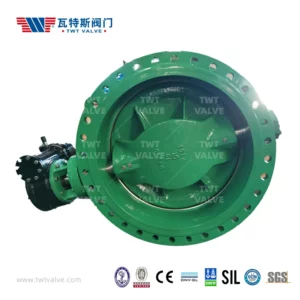The double offset design of a butterfly valve reduces friction between the disc and the seat by offsetting the axis of rotation of the disc from the center of the valve body and the axis of the valve stem. This creates a cam-like action as the disc rotates, which lifts the disc away from the valve seat as it opens, reducing contact and friction between the disc and the seat.
When the valve is closed, the disc is pressed tightly against the valve seat, creating a seal. As the valve opens, the disc rotates away from the seat, with the center of rotation moving further away from the valve seat. This creates a lifting action on the disc,double eccentric butterfly valve China which reduces the amount of contact and friction between the disc and the seat, resulting in less wear and tear on the valve and improved durability.
The double offset design also helps to reduce wear on the valve seat and disc by minimizing the amount of sliding contact between the two components. This reduces the risk of galling or damage to the valve seat or disc, which can lead to leaks or valve failure.
Overall, the double offset design of a butterfly valve provides improved performance, durability, and reliability compared to other valve designs by reducing friction and wear between the disc and the seat.
How does the double offset design compare to other valve designs?
Compared to other valve designs, the double offset butterfly valve has several advantages, including:
Reduced friction: The double offset design of the butterfly valve reduces friction between the disc and the seat, resulting in improved durability and reduced wear on the valve components.
Tight seal: The double offset design provides a tight seal between the disc and the seat, even at high pressures, which reduces the risk of leakage or failure.
Improved flow control: The butterfly valve’s disc can be rotated to precisely control the flow of fluid through the valve, making it a versatile valve design that is suitable for a wide range of applications.
Lower cost: Compared to other valve designs, such as ball valves or globe valves, butterfly valves are often less expensive to manufacture, install, and maintain.
Lighter weight: Butterfly valves are typically lighter weight than other valve designs, which can make them easier to install and handle.
However, there are also some disadvantages to the double offset butterfly valve design. For example:
Limited temperature and pressure range: The double offset design may not be suitable for high-temperature or high-pressure applications, as the valve components may not be able to withstand the stress.
Limited control: While butterfly valves provide good flow control, they may not be as precise as other valve designs, such as globe valves.
Limited resistance to abrasion: The butterfly valve’s disc may not be as resistant to abrasion as other valve designs, which can reduce the valve’s lifespan in certain applications.
Overall, the double offset butterfly valve is a versatile and reliable valve design that is well-suited for a wide range of applications. While it may not be suitable for all applications, the butterfly valve’s advantages in terms of reduced friction, tight sealing, flow control, and lower cost make it a popular choice for many fluid control applications.

